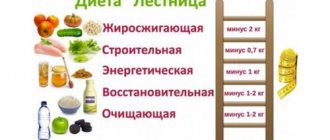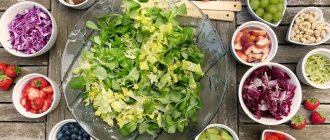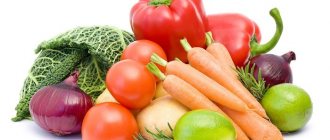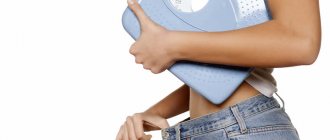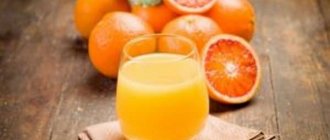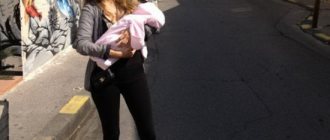Description of the protein-free diet
The essence of a low-protein diet is to reduce the amount of protein in the diet. The macronutrient is not completely abandoned, as it is dangerous for the body. WHO recommends consuming an average of 0.75 g of protein per 1 kg of weight. When dieting, this amount is reduced to 0.55 g. They do not refuse meat, fish and poultry, but reduce the portions.
Healthy people are advised to follow a protein-free diet for no more than 7 days.
Advantages and disadvantages of a protein-free diet
The positive aspects of using a special diet include the following:
- reduction of acidity in the stomach;
- cleansing of existing stagnation in the intestines, waste, toxins;
- reduction of disease symptoms;
- getting rid of swelling;
- reduction in body volume.
It is important to note that weight loss occurs only due to the removal of excess fluid, and is temporary. All lost kilograms will return immediately after completing the course.
The lack of sufficient protein leads to a slowdown in metabolic processes and stress. The consequences of violations may be hair loss, brittle nails, and loss of skin elasticity.
In addition to negative health consequences, the diet has many contraindications, including for women during pregnancy and breastfeeding. An unbalanced system is unacceptable for use in childhood, adolescence and old age.
Recommendations from experts
The main rule before reducing your protein intake is to consult your doctor. This is especially important if a person suffers from various types of diseases. If the doctor is notified about following a protein-free diet, or any other diet, he will be able to make adjustments to the menu to improve the result, as well as prevent side effects.
Cutting off access to one macronutrient in case of kidney disease is, of course, not enough. You also need:
- Reduce fluid intake to your daily urine output. This is approximately 300-400 ml.
- Consume no more than 20 grams daily. proteins, 80 gr. fat and 350 gr. carbohydrates.
- Eliminate salt and sugar from your diet.
- Eat 5-6 times a day in small portions.
- Minimize physical activity and any other activities that require a lot of energy.
- Create a menu in such a way that a person consumes less than 2200 kcal per day.
It is important to have an idea of exactly which foods the low-calorie food system allows and which it prohibits. Acceptable items include: cereals, boiled potatoes, fruits and vegetables (stewed, in the form of gravy in butter), bread, homemade bread and other baked goods (without adding salt and eggs), jellies, jelly and compotes, jams, preserves and honey, pancakes and pancakes (sometimes using yeast), as well as all dairy and fermented milk products (cheese and cottage cheese in small quantities).
The prohibited list includes sweets, protein foods such as fish, any meat, seafood and eggs, as well as legumes.
Additional recommendations
At the initial stage of kidney damage, the amount of protein consumed should be calculated at 800 mg/kg body weight. It is better to replace ordinary bread with a product that lacks protein. At this stage, patients do not need to take medications that contain amino acids.
In case of stage 2 renal failure, the amount of protein consumed should be limited to 400–500 mg per 1 kg of body weight.
To reduce the concentration of phosphates, products must be thoroughly boiled. It could be rice, potatoes or fish. To compensate for amino acid deficiency, special drugs are prescribed (for example, Ketosteril).
At stage 3 chronic renal failure, the amount of protein is calculated at 300 g/kg body weight. In this case, the patient is additionally prescribed amino acid preparations.
In conditions of minimal protein intake into the body, it is necessary to carefully monitor the nitrogen balance and limit the amount of potassium consumed (potatoes, raisins, dried apricots, etc.).
Indications for dieting
The main indications for prescribing a therapeutic diet include cancer, kidney disease and pathologies of the lymphoid tissue of the brain. Sometimes protein intake is limited due to liver disorders. Short-term reduction of the proportion of amino acids in the menu with high blood pressure.
Oncological diseases
Scientists suggest that proteins serve as food for cancerous tumors. The latter produce energy during the fermentation of amino acids. Experiments have shown that the growth of tumors does not stop even with an 80% restriction of meat products on the menu. It is believed that casein stimulates the development of tumors most of all. Some doctors also advise reducing the proportion of methionine in the menu. Without it, the growth of tumors in the mammary glands is impossible.
It is not recommended to completely give up protein, despite research results, since tumors will receive amino acids from muscle tissue. However, moderate restriction slows down the growth of tumors.
Kidney diseases
With kidney disease, their ability to filter deteriorates. This means that metabolic products are removed from the body more slowly. This primarily concerns creatinine, a by-product that is formed during the breakdown of protein molecules. This compound has no functional purpose and is harmful to the body. When it increases, a person experiences muscle pain, weakness, and swelling. To prevent the accumulation of creatinine in tissues, the amount of protein consumed is reduced so that diseased kidneys have time to cope with its excretion.
Pathologies of brain lymphoid tissue
Most often, pathologies of the lymphoid tissue of the brain are oncological in nature. In this case, exclusion of proteins is required to slow down the growth of tumors and prevent the emergence of new lesions.
When following a protein-free diet, you must strictly follow its basic rules.
General rules
The general rules of a low protein diet are as follows:
- Salt and hot spices are removed from the diet. You can minimize their number, but it is better to refuse completely. This is especially important for kidney diseases, since spicy and salty foods irritate the kidney tissue.
- The proportion of liquid is controlled. Try to drink 2 liters per day. In case of kidney disease, the amount of fluid, on the contrary, may be limited.
- When preparing dishes, gentle processing methods are used.
- Switch to fractional meals. Eat up to 4-6 times a day. Portions should be small: 250-300 g. You can eat after 18 hours, but you need to have dinner 2-3 hours before bedtime.
- Strength training, sports and any vigorous physical activity are avoided. A low-protein diet is accompanied by weakness. To preserve the functions of internal organs, the body breaks down muscles into amino acids. For this reason, you should not strain yourself, otherwise you will make your exhaustion worse.
They consume approximately 80 g of fat, 350 g of carbohydrates and 20-30 g of protein per day, which is 2200 calories. Macronutrient amounts may vary depending on weight.
It is advisable to make calculations together with a nutritionist.
Authorized Products
The menu includes the following dishes:
- Lean meats: beef, chicken, veal and turkey. It is recommended to boil them first, then bake if desired. The size of one serving is 55-60 g. The meat is served along with vegetable side dishes.
- Low-fat fish: cod, pike perch, pike, pollock, etc. It is preferable to first boil the product, then bake it or eat it as is.
- Vegetarian soups. They are prepared without the use of rich broths. It is allowed to add vegetables or cereals, but not meat. Serving size is 250-300 ml.
- Bread. Only a special protein-free one will do. It is eaten with other dishes.
- Vegetables. Salads and side dishes are prepared from potatoes, cucumbers, cabbage, carrots, beets and tomatoes. In the second case, vegetables are stewed or boiled. It is allowed to decorate dishes with dill, parsley and green onions, if there are no kidney pathologies. If there are diseases, any products with essential oils should be removed from the diet.
- Eggs. Protein omelettes are prepared from them. Serving: 1 egg. You can add butter or vegetable oil to the dish.
- Sago. Serves as a replacement for standard side dishes: pasta, cereals and legumes. Sago does not contain protein or gluten, so it is often added to the diet for therapeutic nutrition. The product is used to prepare casseroles, pies, porridges, cutlets, etc.
- Berries, fruits and dried fruits. The latter are limited in case of chronic renal failure. Additionally, in case of pathology, fruits and berries are consumed only in boiled form, compotes, fruit drinks, etc. are prepared from them. This is due to the need to reduce the proportion of potassium consumed. In other cases, berries and fruits are allowed to be eaten raw.
- Fermented milk and dairy products. You are allowed to eat up to 50 g of cottage cheese or up to 200-300 g of kefir, fermented baked milk, homemade yogurt or any equivalent per day.
- Beverages. Rosehip infusion, natural vegetable and fruit juices, coffee and tea are suitable.
On a diet, it is recommended to eat foods that contain a minimum of protein, and it is forbidden to eat those that contain a lot of it.
Low protein diet
A low-protein diet belongs to the therapeutic category and is prescribed by a medical specialist as one of the therapeutic measures for chronic lesions of the kidney or liver parenchyma. This nutritional system is considered effective for chronic renal failure. An independent transition to a diet can lead to serious disruptions in the functioning of the entire body.
The main principle of a low-protein diet is to reduce the amount of protein consumed, which ultimately leads to a decrease in the load on the functional units of the liver and kidneys, creating optimal conditions for restoring the metabolic processes occurring in them. During the diet, the amount of protein consumed is strictly limited, and it is extremely important that muscle fiber proteins are not used to satisfy the body’s plastic needs, and that the body receives all the necessary essential amino acids.
For healthy people, following a low-protein diet is not only undesirable, but also dangerous, especially for those who are trying to lose weight or create an impeccable figure.
Pros of the diet
1. A low-protein diet allows you to reduce the protein load on the body.
2. Provides optimal conditions for restoring liver and kidney function.
3. Prevents the accumulation of nitrogenous compounds in the blood.
4. Improves the general condition of the body.
5. Launches detoxification processes.
Cons of the diet
1. May be accompanied by a decrease in the activity of plastic processes.
2. With insufficient intake of vitamins and microelements, immunity decreases.
3. There is a loss of strength.
4. During the diet, there is a deterioration in mood.
5. Diet can cause muscle loss.
Meal plan (menu)
During a low-protein diet, the amount of protein in the daily diet is significantly reduced (up to 60 g). All proteins consumed must be of high quality, that is, easily digestible and contain both essential and essential amino acids. In addition, it is important to reduce the volume of fluid consumed to 1 liter, which will reduce the functional load on the renal tissue.
For the entire duration of the diet, foods that can irritate the kidney parenchyma (coffee, cocoa, chocolate, dishes with extractive substances of a nitrogenous nature) are completely excluded from the diet. Even low-alcohol drinks are not allowed.
Fractional meals are recommended, which should provide the body with the necessary energy and ensure the supply of sufficient fats and carbohydrates.
The approximate daily menu for this diet is as follows.
Breakfast: hard-boiled chicken egg, mashed potatoes with butter, unsalted tomato juice, tea with honey.
Second breakfast: vegetable casserole.
Lunch: cauliflower soup, zucchini fritters, dried fruit compote.
Afternoon snack: baked apples.
Dinner: stewed pumpkin with apples, carrots and raisins, tea with honey.
Physical activity
During the diet, physical activity should be kept to a minimum.
Contraindications
The diet is therapeutic, that is, it is prescribed by a doctor familiar with the patient’s physical condition, and therefore has no contraindications.
Prohibited Products
The list of prohibited products includes the following:
- Meat and fish broths. Protein substances remain in them.
- Alcohol and carbonated drinks, including beer and wine. They aggravate the human condition in pathologies. Drinking alcohol accelerates the breakdown of muscle fibers. Gases in drinks negatively affect the condition of the mucous membranes.
- Flour and confectionery products. Contains vegetable proteins. They are rich in fast carbohydrates, which is bad for your health. There are almost no useful substances in such products.
- Legumes. They are completely removed from the menu because they are rich in proteins.
It is recommended to avoid grains. In the absence of pathologies, you can limit their use. The proportion of milk, animal fats and eggs in the menu is reduced. In case of cirrhosis and kidney pathologies, any salty foods are removed from the diet. This applies not only to marinades and chips, but also to bouillon cubes, nuts in bags, etc. With chronic renal failure, the intake of potassium and phosphorus is limited.
Bread with bran, cheese, bananas, and chocolate are prohibited. Fast food is not consumed, regardless of health status.
Approximate menu for the week
The list of dishes on the menu depends on the person’s health status and the chosen diet option. In the absence of pathologies, it is recommended to prefer a gentle diet.
Gentle option
With such a diet, the menu may look like this:
- Monday. Breakfast: applesauce and apricot juice. For lunch they eat vegetarian soup and a small portion of boiled veal, as well as fruit salad and cherry puree mousse. Dinner: pilaf with sago fruit, egg white omelette and tea.
- Tuesday. 2 soft-boiled eggs and buckwheat porridge in the morning. In the afternoon - vegetarian borscht, boiled potatoes or mashed potatoes, a portion of boiled meat and compote. In the evening - apple and carrot balls, fruit pilaf and apple juice.
- Wednesday. In the morning - vegetable salad, buckwheat cereal and baked apple. In the afternoon - rice porridge, boiled meat, vegetable soup and compote. In the evening - steamed egg white omelette, apple fritters, juice.
- Thursday. Rice pudding, grated carrots, candy without chocolate for breakfast. Lunch - vegetarian soup, rice and boiled chicken with milk sauce, vinaigrette. In the evening - potato pancakes with sour cream, baked apple, vegetable juice.
- Friday. In the morning - protein omelet, fruit salad. In the afternoon - lean borscht without meat, vegetable casserole, stew. In the evening - beetroot and carrot cutlets, milk pudding.
- Saturday. Breakfast - cottage cheese casserole and sour cream, fruit mixture. Lunch - potato soup with vegetables, sliced cucumbers and herbs, rice balls. Dinner - buckwheat porridge with milk.
- Sunday. In the morning - a soft-boiled egg, sago milk porridge with the addition of prunes. In the afternoon - vegetable soup with noodles, boiled fish, mashed potatoes and vinaigrette. In the evening - pilaf from sargo with vegetables and raisins.
Sample menu for a day on a protein-free diet.
Hard option
For a strict diet, the following menu is suitable:
- Monday. In the morning - oatmeal milk porridge with jam, fruit. In the afternoon - cauliflower soup, baked potatoes, berry jelly. In the evening - cabbage rolls, vegetables and rice, rosehip decoction.
- Tuesday. Breakfast - baked cauliflower with sour cream and pancakes, fruit. Lunch - vegetable soup, buckwheat with vegetables, compote. Dinner - vegetable pilaf, jelly.
- Wednesday. In the morning - oatmeal milk porridge, pumpkin puree with jam. In the afternoon - vegetarian soup, mashed potatoes, tea. In the evening - potato pancakes, sour cream, apple juice.
- Thursday. In the morning - carrot and pumpkin casserole with honey, tofu or cheese. In the afternoon - buckwheat soup, zucchini stuffed with vegetables, jelly. In the evening - fruit pilaf from sago.
- Friday. Breakfast - grapefruit, zucchini pancakes, cheese. Lunch - semolina soup with vegetables, pancakes, jelly. Dinner - stewed cabbage, rice, vegetable juice.
- Saturday. In the morning - pancakes on dairy-free dough with honey or jam. In the afternoon - vegetarian borscht, cabbage and vegetable cabbage rolls, jelly. In the evening - millet porridge with pumpkin.
- Sunday. In the morning - oatmeal with milk and dried apricots. In the afternoon - rice soup with mushrooms, mashed potatoes, compote. In the evening - buckwheat krupenik with the addition of raisins, pumpkin and cottage cheese.
Protein-free menu for children
In childhood, a protein-free diet is rarely used, since the growing body needs protein in full. If a dietary diet is recommended for a child for medical reasons, it should be combined with physical exercise: morning exercises and regular walks in the fresh air.
A typical menu for a week on a protein-free diet for a child:
| Day | Breakfast | Dinner | Dinner |
| Monday | Milk porridge, strawberry jam | Vegetable soup with sour cream | Buckwheat porridge, kefir |
| Tuesday | Toast with melted cheese | Citrus fruits, yogurt | Kiwi, orange juice |
| Wednesday | Boiled egg, tea with lemon without sugar | Millet, dried fruits | Vegetables, lettuce |
| Thursday | Buckwheat porridge, boiled egg, kefir | Oatmeal with dried apricots and prunes | Boiled rice, apple juice |
| Friday | Omelet with steamed tomatoes, orange juice | Soup with low-fat meatballs | Dried fruits |
| Saturday | Toast with jam, milk | Sour cream with cottage cheese, weak black tea | Low-fat fish cutlets with kefir |
| Sunday | Scrambled eggs with herbs, carrot juice | Cucumbers, cabbage, tomatoes | Buckwheat porridge, herbal tea |
Dish recipes
To make the menu more attractive, you can try cooking a few new dishes.
Milk porridge with jam
To prepare porridge, take 0.5 liters of milk, 180 g of wheat cereal, rice or oatmeal and 1 tbsp. l. jam. Milk is poured into a saucepan, a little water is added, and put on fire. After boiling, add the cereal and cook for 15-20 minutes, stirring. After the stove is turned off, the porridge is covered with a lid, allowing it to evaporate. Add jam before serving.
Vegetable pickle
To prepare you will need 2 pickled cucumbers, 3 potatoes, 1 carrot, 80 g of rice, parsley, dill, 1 onion and bay leaf. Place a pan of water on the fire, bring to a boil, add all the vegetables, cut into small cubes, except cucumbers. The latter are introduced 10 minutes before readiness along with the herbs, then simmer the dish over low heat.
Stewed zucchini with tomatoes and peppers
To prepare the dish you will need 2 zucchini, 1 sweet potato, 2-3 tomatoes, 1 onion and 1 tbsp. l. vegetable oil. Peppers and zucchini are cut into half rings, and the onion is chopped. Vegetables are sautéed in a frying pan with a small amount of oil. Tomatoes passed through a meat grinder are added to the mixture after 7 minutes, then all ingredients are simmered under a closed lid for 10 minutes. The finished dish is decorated with herbs.
Despite significant restrictions, with a protein-free diet you can eat tasty and satisfying meals.
Vegetarian pilaf
To prepare vegetarian pilaf you will need 2 tbsp. rice, 1 can of canned corn, 1 onion, 2 carrots, 2 tbsp. l. tomato paste and 2 tbsp. l. vegetable oil. First, finely chop the onion and grate the carrots. The mixture is simmered in a frying pan for 5 minutes, then tomato paste and corn are added. After 5 minutes, pour the soaked rice into the frying pan, mix the ingredients and pour boiling water so that the water covers the vegetables. Simmer everything together under the lid for half an hour.
For overweight people
In this situation, any meat and flour products, as well as salt, are almost completely excluded from the diet. Menu for a week with a protein-free diet for weight loss:
| Day | Breakfast | Dinner | Dinner |
| Monday | Cottage cheese, oat porridge, jam | Macaroni and cheese, milk sausages | Vegetables, diet bread |
| Tuesday | Strawberries with cream, weak black coffee | Millet with prunes, orange juice | Processed cheese with rye bread, low-fat kefir |
| Wednesday | Milk porridge with jam, tea with lemon | Stewed zucchini with tomatoes and peppers, apple compote | Low-fat fish cutlets |
| Thursday | Buckwheat porridge, kefir | Lettuce, cucumber, carrots | Banana, kiwi, strawberry, low-fat yogurt |
| Friday | Honey toast, coffee with cream | Millet, tea | Oatmeal, milk |
| Saturday | Finely chopped cucumbers with cabbage and sour cream, kefir | Boiled rice, low-fat fish cutlets | 250 g chicken, tomatoes |
| Sunday | Carrot puree, apple compote | Oatmeal, milk | Fruits, black unsweetened and weak tea |
Weekly protein-free menu for weight loss
A protein-free diet can be used for medicinal purposes and to eliminate accumulated excess weight. In this case, you need to study a sample menu for the week, consisting of such products in the table below.
| Day of the week | Menu |
| Monday | Unlimited raw vegetables |
| Tuesday | Unlimited raw vegetables |
| Wednesday | Fruits combined with vegetables (potatoes, carrots, apples, pears) |
| Thursday | Boiled vegetables |
| Friday | Boiled vegetables with fermented milk products (kefir, yogurt) |
| Saturday | Boiled vegetables with fermented milk products (kefir, yogurt) |
| Sunday | Vegetables with the addition of any kind of greens |
If we compare a protein-free diet with other methods, it is not so effective for losing weight, since losing weight within the stated time frame is quite difficult with minimal protein restriction and a predominance of carbohydrates in the daily diet.
The menu for following a protein-free diet in the presence of kidney pathology has some differences.
| Meal times | Menu |
| Breakfast | Oatmeal 30 grams White bread 30 grams Jam or jam 30 grams Sweet tea |
| Dinner | Salad with peeled cucumbers without adding dressing 150 grams Borscht with low-fat meat broth 1 plate Pasta with stewed beef 300 grams Rye flour bread 40 grams Tea with sugar |
| Afternoon snack | Baked pie with cabbage 80 grams Peeled apple |
| Dinner | Cabbage salad with sunflower oil 160 grams Boiled rice 300 grams Fish cutlet 100 grams White bread 40 grams Tea with sugar |
| Snack before bed | Kefir 125 ml Cookies 50 grams |
Recommendations from nutritionists
Maria Anatolyevna, 52 years old, nutritionist A protein-free diet is a therapeutic diet that is prescribed for gout, chronic renal failure, oncology and other diseases.
You cannot switch to it on your own, since this is fraught at best with exhaustion, and at worst with the development of chronic pathologies due to a lack of amino acids. The latter are building materials for the body, therefore they are required by all people for normal life. Svetlana Vladimirovna, 45 years old, nutritionist Reducing protein in the diet is justified only if a person has medical indications. To lose weight, it is strongly recommended to reduce the proportion of carbohydrates and pay attention to the quality and quantity of fat consumed. The body needs all macronutrients. With a low-protein diet, the human body suffers from amino acid deficiency, but in some pathologies the benefits outweigh the risks. Healthy people do not need to risk their health.
Protein-free diet according to Andreas Moritz
This technique has gained great popularity, as it is divided into separate stages, described in detail in the list below:
- preliminary preparation , which is based on the daily consumption of apple juice in the amount of 1 liter for 6 days. The liquid effectively cleanses the body and flushes the bile ducts. The product should be drunk between meals and should not be used before bedtime;
- if you are allergic to apple juice, it must be replaced with loosestrife tincture, which can be purchased at a pharmacy.
The use of the technique implies the exclusion of taking medications, biological additives, animal fats, fried and dairy products;
- The main stage of the diet is to take oatmeal for breakfast and boiled rice for lunch . When 14.00 comes, you must completely stop eating. You can drink purified water and a solution with salt, divided into 3 doses. Before going to bed, you need to prepare a mixture of grapefruit and lemon juice with 125 ml of olive oil. Drink the resulting liquid at 22.00;
- at the final stage, take the final portion of the previously prepared solution, and eat light food for lunch. To obtain the proper result, the process is carried out 5–7 times.
Necessary recommendations
Before you start following a protein-free diet, you should pay attention to the following tips:
- obtaining the approval of the attending physician;
- using safe cooking methods (steaming, baking, stewing);
- the maximum time for using the diet should not exceed two weeks;
- compliance with bed rest, if necessary (in the acute course of a chronic disease);
- parallel use of complexes with the maximum content of vitamins and essential microelements, which have a positive effect on the recovery of the body.
In terms of quantitative content, the daily diet should have the following proportions:
- 25–30 grams of protein;
- 60–65 grams of fat;
- 350–360 grams of carbohydrates.
A person's need for protein per 1 kilogram of body weight in the muscle layer is 2 grams. Over a set period of diet, you can lose 5–7 kg. At the same time, the main task of a limited diet is to cleanse the body and prevent the development of potential or chronic diseases.
Reviews and results
Marina, 37 years old, Voronezh. She set a goal for herself - to lose 5 kilograms by summer.
Beach season was approaching, so I needed to look good. I went on a protein-free diet and began to exercise intensively. I felt terrible, but I was happy to lose 2 kg in the first few days. By the end of the week the goal was achieved, but at great cost. When I began to evaluate the results, I realized that I had suffered in vain. The number on the scales has changed, but the skin has sagged and the defects have worsened. Elena, 34 years old, Krasnodar I wanted to lose weight on a protein-free diet, but did not read the information in advance. I've been struggling with the consequences for six months now. In the first days I lost 3 kg. Now I understand that due to water and limiting salt. A week later, my health deteriorated greatly and I felt weak. After 2 weeks I could barely get out of bed, but I had already lost 5 kg, so I decided to continue. A month later I had to see a doctor: I returned to my previous diet, but began to suffer from digestive disorders, and my condition only worsened. The doctor scolded me and said that the weight I lost was muscle.
How to make a menu correctly
When starting any diet, it can be quite difficult to get started. The whole difficulty lies in studying the permitted products and forming from them a suitable menu that meets the goals of adhering to a certain nutritional system. To simplify this task, you can first use the basic diet options.
If a person nevertheless decides to go on a protein-free diet for weight loss, his menu for the week will consist of small mono-diets.
- Monday and Tuesday are a vegetable feast. During this period, you can eat up to 2 kg of cucumbers, tomatoes, peppers, etc.
- Wednesday is dedicated to pears and apples. Including them in your diet will improve your metabolism.
- Thursday will consist exclusively of steamed vegetables and jam.
- On Friday and Saturday you can eat yogurt, vegetables and dishes made from them.
- Sunday – we eat only greens and vegetables.
Such a strict regime can help you get rid of 7 to 10 kg per week, but health problems cannot be ruled out.
Following a low-protein diet for medicinal purposes can begin with the following menu:
Category of peopleBreakfastSecond breakfastLunchDinner
| With kidney diseases (weight loss by 5-7 kg) | 2 eggs (white) + 2 tomatoes + 200 ml milk. | Dried fruits. | Vegetable stews or fruit salads. | Vegetable salad. |
| With cancer (2 weeks) | 100 gr. buckwheat porridge on water. | Apples. | Bread with boiled vegetables. | Buckwheat porridge + 2 tomatoes. |
| Diabetics (no more than 1 time in 2 months) | Cabbage salad + tea. | Tomato or cucumber. | Pasta + boiled vegetables. | Beet salad dressed with vegetable oil. |
| With rheumatoid arthritis (2 weeks) | Buckwheat porridge with milk + 1 carrot cutlet + a cup of tea without sugar. | Fruits or vegetables. | 2 boiled potatoes + vegetable soup + compote. | Lenten pilaf + vegetable salad + a cup of jelly. |
| Pregnant women (2 weeks; minus 5 kg) | 100 gr. buckwheat porridge + 2 apples. | Yogurt. | Pancakes + pasta + milk. | Vegetable stew or salad. |
| Nursing mothers (no more than 1 week; up to 4 kg may be lost) | 100 gr. semolina or buckwheat porridge with milk + jelly. | Fruits or vegetables. | 2 boiled potatoes + lean soup. | Vegetable salad. |
